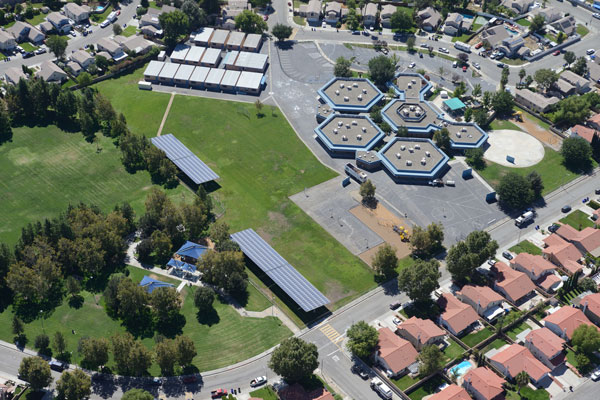Like many others, school districts in California experience budget crunches. Reallocating existing funds is usually the first solution, but instead of cutting from the arts or band, why not trim down fixed operational costs—like electricity?
Constellation, a competitive energy company, works with variety of businesses and institutions to help them do just that through affordable and accessible options for distributed energy solutions, like solar. The company recently completed a solar project for The Chaffey Joint Union High School District in Southern California, which allowed the school district to install the system at no upfront cost.
This was achieved through a power purchase agreement (PPA) contract model, which delivers the benefits of solar energy to educational institutions and businesses, while unlocking potentially significant savings on their energy costs. Through Constellation’s end-to-end management of on-site solar installations, schools are able to free up time and funds to focus on what is really important—a win for any school district.

The complete 6.76-megawatt (MW) array will provide approximately 11,000 MW hours of energy to eight schools, which is enough power to meet approximately 46% of the school district’s energy needs. The solar panels will be mounted on a combination of carport and shade structures—providing shade to cars while simultaneously generating solar energy. Shade structures, which look very similar to carports, are typically built in recreational areas for children, especially valuable in sunny places like Southern California.
“Power purchase agreements are a great option for school districts like Chaffey,” says Brendon Quinlivan, director, distributed energy origination for Constellation. ”By financing the construction and maintenance costs for solar, schools avoid the costly installation and purchasing of panels and realize an immediate benefit of powering their daily operations at a fixed cost that’s often at or below their current electricity rate.” Depending on who retains the solar renewable energy certificates (SRECs) for a project, schools can also reduce their carbon footprint.
The arrangement works by selling the solar power generated by Constellation’s onsite arrays back to the school districts at a discounted rate. The school buys all the power produced by the solar arrays as long as the power purchase agreement is still active. And, as it often offers them substantial savings, it’s an attractive option for schools looking to inject more capital into student services, operations, or other critical projects.
Constellation worked directly with PFMG Solar, which specializes in meeting the energy needs of schools, to develop the solar project for Chaffey. “Some of these schools are paying up to $7 million a year on electricity, so if you’re cutting 25-30% back on their bills, that’s amazing for education,” says Paul Mikos, president of PFMG Solar.
Schools often fall victim to expensive energy costs because they consume power during peak hours (mid-afternoon), making their electricity bills on the whole higher than many other types of buildings and businesses. Having solar panels onsite means that instead of simply using energy during peak hours, and paying top dollar for it, schools are now involved in producing energy during the peak, which reduces the amount of power they need to purchase from the grid and helps them realize savings. “You can think of it like a piggy bank,” says Zeb Wallace, senior business development manager at Constellation, “When the solar system produces more than the needs of the school, like in the summer when there’s virtually no activity, energy credits are deposited into the bank, which can then be applied when school goes back into session.”
The solar array also comes with educational benefits, encouraging a dialogue for young children on alternative energy, sustainability, and our closest star—the sun. “We’ve written some easier to comprehend programs for students, so they can make sense of how and why solar energy is working at their school, why a sunny day is better than a cloudy day, why a southern facing panel is more productive, etc.,” Mikos explains. Supporting the idea that clean solar power is not only a good option for the environment, but a viable one for schools, or any entity looking to save money and invest in the environment, is a great achievement for Constellation, PFMG Solar, and education—and one which is expanding the landscape of renewable energy. “Frankly, the first reason schools buy solar now is because it’s far less expensive,” Mikos says.
Download a PDF of this story here.
Connect with Constellation: Website | Facebook | Twitter | LinkedIn


